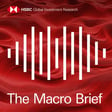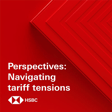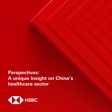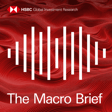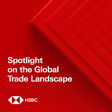Become a Creator today!Start creating today - Share your story with the world!
Start for free
00:00:00
00:00:01

The Macro Viewpoint - Are investors right to be bullish and is Europe’s energy crisis over?
Mark McDonald delves into some unusually positive signals towards risk assets from our machine learning models and Kim Fustier assesses the outlook for the oil and gas markets. Disclaimer: https://www.research.hsbc.com/R/51/NJBKCdv Stay connected and access free to view reports and videos from HSBC Global Research follow us on LinkedIn https://www.linkedin.com/feed/hashtag/hsbcresearch/ or click here: https://www.gbm.hsbc.com/insights/global-research.
Hosted on Acast. See acast.com/privacy for more information.
Transcript
Introduction to Podcast Series
00:00:01
Speaker
Welcome to HSBC Global Viewpoint, the podcast series that brings together business leaders and industry experts to explore the latest global insights, trends, and opportunities.
00:00:13
Speaker
Make sure you're subscribed to stay up to date with new episodes.
00:00:16
Speaker
Thanks for listening, and now onto today's show.
The Macro Viewpoint Segment
00:00:23
Speaker
You're listening to The Macro Viewpoint, our weekly showcase of the key views from the team here at HSBC Global Research.
00:00:30
Speaker
This podcast was recorded on Thursday, the 19th of January, 2023.
00:00:34
Speaker
Our full disclosures and disclaimers can be found in the link attached to this podcast.
AI & Market Predictions for 2023
00:00:43
Speaker
Hello and welcome.
00:00:45
Speaker
After a challenging 2022, markets have started the new year with a much more positive tone.
00:00:52
Speaker
Can this continue?
00:00:53
Speaker
We look at how artificial intelligence and machine learning models can help us peer into the future.
00:01:00
Speaker
And we look at what's behind a big price correction in the oil and gas markets and ask whether the worst of Europe's energy crisis is now behind us.
00:01:13
Speaker
Hello, I'm Aline Van Dyne.
00:01:15
Speaker
And I'm Piers Butler.
00:01:17
Speaker
Markets have started 2023 in an upbeat mood with most major asset classes making gains.
00:01:23
Speaker
The big question is whether the worst is indeed over or is this simply a blip in a longer bear market for risk assets?
00:01:31
Speaker
In their latest report, our data science team used machine learning techniques to find out whether this shift in sentiment is justified.
00:01:40
Speaker
Mark McDonald, Head of Data Science and Analytics, joins us to talk through the findings.
Predictive Models and Market Trends
00:01:46
Speaker
Mark, welcome to the podcast.
00:01:49
Speaker
Hi, thanks for having me on.
00:01:51
Speaker
So, Mark, very interesting that your models are pointing to a more positive tone ahead in the markets.
00:01:58
Speaker
Well, yeah, I mean, obviously the markets have started 2023 on a much more positive tone than many people were expecting.
00:02:06
Speaker
And the big question is, is this likely to continue or is it just a blip, a flash in the pan?
00:02:14
Speaker
And when we look at our predictive machine learning models, these are all trained with a sort of one month ahead look ahead window.
00:02:21
Speaker
So they're very tactical, but they're all pointing in the same direction at the moment.
00:02:24
Speaker
There's a great deal of positivity.
00:02:27
Speaker
So for example, our global equities pullback model that assesses how likely it is that equity markets will fall over the coming month, that sees currently only a 33% probability of equities falling.
00:02:40
Speaker
And we have a variety of different country level models as well.
00:02:45
Speaker
For example, the mainland China equity pullback model sees only a 7% probability of equities falling over the coming month.
00:02:53
Speaker
And these are very, very positive numbers.
Bullish ML Models & Eurozone Macro Data
00:02:57
Speaker
And the way that we use these models, you know, it's that the classic criticism of machine learning has always been that they're black box models.
00:03:05
Speaker
Data comes in and predictions come out and who knows why.
00:03:08
Speaker
But that's not valid anymore.
00:03:10
Speaker
So we don't just look at the probability that comes out of the model and the prediction.
00:03:15
Speaker
We look at the prediction plus the explanation.
00:03:18
Speaker
And we can see that for some of our models, like the pullback models, almost all the categories of inputs to the model are actually pushing the model in the direction of being bullish.
00:03:27
Speaker
It's a very broad-based signal.
00:03:30
Speaker
And the drivers of our various other models as well, they all make sense as drivers.
00:03:35
Speaker
So often it's things like, you know, macro data is coming in better than expected, particularly in the Eurozone.
00:03:42
Speaker
And I think it's really this expectations component that...
00:03:45
Speaker
that is quite an importance of the current market positivity.
00:03:48
Speaker
Is it unusual to see so many of the models pointing in the same direction?
00:03:54
Speaker
Like, just give us some historical context in terms of how strong these signals are that you're getting from these models.
00:04:02
Speaker
These are some very strong signals at the moment.
00:04:05
Speaker
We have a variety of different models.
00:04:07
Speaker
I'll talk about the different categories.
00:04:10
Speaker
One, we have a family of pullback models.
00:04:13
Speaker
These are models that assess equity markets on an absolute return basis.
00:04:18
Speaker
They're just asking the question, is a specific equity market going to fall over the coming month or not?
00:04:25
Speaker
Those models, different equity markets are correlated to each other and they have similar inputs to the models.
00:04:32
Speaker
So those models moving together is not that unusual.
00:04:35
Speaker
Although you will normally find in any typical week that you update the model that some markets are showing a high risk and some markets are showing at low risk.
00:04:45
Speaker
At the moment there are no models, there are no country level models showing a high risk of a pullback.
00:04:51
Speaker
So that's fairly extreme.
00:04:53
Speaker
We have our other models that are more relative return models.
00:04:56
Speaker
So we have Marvin, which looks at the trade-off between equities and bonds, and Remy, which looks just within equity markets, but our EM equity is going to outperform DM equities.
00:05:07
Speaker
Those two models are also showing very bullish.
00:05:10
Speaker
And the combination of all three of them lining up in the same direction is relatively unusual.
Market Stress & Asset Correlations
00:05:16
Speaker
It's noteworthy as well, given the expectations many people had coming into this year.
00:05:23
Speaker
And what about the risk on risk off signals?
00:05:27
Speaker
Yes, I mean, these, we look at a variety of sort of classic indicators of market stress based on, you know, analysis of volatility or correlations in the case of our risk on risk off indicator.
00:05:41
Speaker
We look at that really as a way of trying to assess what's the slightly longer term prognosis because these models of ours, they're trained with a one month horizon.
00:05:50
Speaker
So they're very tactical and them all lining up in the bullish direction is quite strong underpinning for the recent positivity to continue for the short term.
00:06:00
Speaker
But for the longer term, what we really need to assess is, are things improving?
00:06:05
Speaker
Are we over the worst?
00:06:08
Speaker
And so with our risk on risk off indicator, this measures the sort of aggregate strength of correlations amongst asset classes.
00:06:15
Speaker
And at the moment, we measure this over a six month window.
00:06:19
Speaker
And that correlation is currently very high over the last six months.
00:06:22
Speaker
And this is a typical sign of market stress, because what it's really telling you is these are very disparate asset classes.
00:06:29
Speaker
And if they're all super correlated with each other, then that means that they're really being driven by the same factor.
00:06:34
Speaker
And that is atypical and it's not a healthy market situation.
00:06:39
Speaker
If we look over much more narrow timeframes, let's say over the last three months, you can see that these correlations are really starting to dissipate.
00:06:47
Speaker
That stress is starting to weaken.
00:06:49
Speaker
And that is a good sign.
00:06:50
Speaker
It's a healthy sign for markets that markets are, individual assets are starting to respond
00:06:56
Speaker
to their own idiosyncratic drivers.
00:06:59
Speaker
And so that is definitely a positive tone.
00:07:02
Speaker
And there are other similar signals that we look at in data matters that track these kind of indicators.
00:07:09
Speaker
And many of these sort of signs of market stress are, they're high, but when you dig under the surface and look on a sort of shorter time frame or look more carefully at the analysis, then you can see that actually the
00:07:23
Speaker
the signs are that the stresses are beginning to dissipate.
00:07:27
Speaker
Mark, thanks so much and hopefully you'll be giving us more updates as we try and figure out how long the positive tone can last.
2023 Key Trends: China's Reopening & Inflation
00:07:37
Speaker
Yes, of course, we'll be updating these frequently.
00:07:44
Speaker
I'm Harold van der Linde.
00:07:45
Speaker
And I'm Fred Newman.
00:07:46
Speaker
And you can find us under the banyan tree.
00:07:48
Speaker
Join us weekly on our new podcast where we bring Asian markets and macroeconomics into context with special insight from our regional experts here at HSBC Global Research.
00:07:59
Speaker
Search for HSBC Global Viewpoint on Apple Podcasts or Spotify or join us via the HSBC Global Banking and Markets page on LinkedIn.
00:08:08
Speaker
Enjoy the rest of your podcast and we'll see you under the banyan tree.
00:08:13
Speaker
This week, we published a 2023 HSBC House Views Report, where our economists and strategists present their views for the year ahead.
00:08:22
Speaker
That's right, Piers.
00:08:23
Speaker
It brings together all the different asset classes.
00:08:25
Speaker
And just to highlight a few key trends for this year, in economics, China's reopening is clearly key and is expected to lead to a recovery, but it won't prevent a global downturn in early 2023.
00:08:41
Speaker
On the inflation front, we do expect a slowdown, but we aren't expecting rate cuts from the Fed or the ECB.
00:08:50
Speaker
in the coming year.
00:08:51
Speaker
And as for FX, we remain bearish on the dollar.
00:08:54
Speaker
And that's despite the uncertainties around the Fed, the outlook for the US economy and China's recovery, because we still think that the growth inflation mix will continue to improve.
00:09:06
Speaker
Yes.
00:09:06
Speaker
And in terms of fixed income views, we do think the peak in developed market bond yields was established last year.
00:09:15
Speaker
We expect bond yields to fall this year and curve steepening will be a key theme.
00:09:21
Speaker
And as a section on energy markets.
European Gas Market Corrections
00:09:23
Speaker
And actually, that's what we're going to focus on now with Kim Fustier, head of European Oil and Gas Research.
00:09:29
Speaker
Kim, welcome to the podcast.
00:09:31
Speaker
Glad to be here.
00:09:32
Speaker
So, Kim, it wasn't that long ago that one was sitting at the kitchen table looking at our utility bills and thinking, gosh, this is really going to hurt with predictions of significantly rising gas prices and energy prices generally.
00:09:46
Speaker
Things are looking better now.
00:09:47
Speaker
What's happened?
00:09:49
Speaker
Yeah, you're right.
00:09:50
Speaker
Everybody was worried and rightly so.
00:09:52
Speaker
But it's been an extraordinary turn of events for gas markets in Europe.
00:09:55
Speaker
I mean, gas prices have more than halved since mid-December.
00:09:59
Speaker
So Europe, to be fair, had prepared itself for a tough winter, but it's also been lucky.
00:10:04
Speaker
So we've been effectively bailed out by a mild winter so far.
00:10:07
Speaker
We've had higher than average temperatures for nearly four weeks, and that's reduced gas demand for heating quite significantly.
00:10:14
Speaker
So gas demand for heating has been 30% down or more during that period.
00:10:19
Speaker
So that's helped a lot.
00:10:20
Speaker
But there's also been a market response driven by high gas prices.
00:10:24
Speaker
So Europe has attracted record levels of LNG, liquefied natural gas, and the high prices have also caused very steep demand reductions, both in the industrial segment and in household demand too.
00:10:38
Speaker
So what we've seen is storage going from what I would call comfortable levels in December to really plentiful levels right now.
00:10:46
Speaker
So we're actually at record highs for this time of year, despite the loss of Russian gas, which is remarkable.
00:10:51
Speaker
And that's actually good news, not only for what we're experiencing currently in this winter, but for next winter.
00:10:58
Speaker
I think that's right.
00:10:58
Speaker
I think we can say that in just about any scenario, Europe is definitely out of the woods for this winter, even if it gets cold again.
00:11:06
Speaker
Now, next winter does look better too, because high storage at the end of this winter will make it easier for us to refill.
00:11:13
Speaker
ahead of the following season.
00:11:15
Speaker
There's just one wild card to keep an eye on.
00:11:17
Speaker
And that's how quickly China's gas demand will bounce back.
00:11:22
Speaker
China's LNG imports fell last year for the first time ever.
00:11:26
Speaker
And so if demand bounces back quicker than we expect, then China will compete with Europe for very scarce gas resources.
00:11:35
Speaker
And that could pull up gas prices again in the second half of this year.
00:11:38
Speaker
Now, before we get too comfortable, it's fair to say that the situation on gas in Europe is still very tight and will be so for a number of years.
00:11:47
Speaker
That's right.
00:11:48
Speaker
So on the positive side, it does look quite likely that the worst of Europe's energy crisis and the peak in prices are now behind us.
00:11:56
Speaker
However, wholesale gas prices are still much higher than usual.
00:12:01
Speaker
They're still at two to three times higher than normal.
00:12:04
Speaker
And we think that they're unlikely to normalize for a number of years because there's very little new supply from the LNG side that comes online before 2026.
00:12:14
Speaker
And just to finish off, what's the outlook on the oil price?
00:12:18
Speaker
Are we expecting any further announcements from OPEC?
Oil Market Uncertainties
00:12:20
Speaker
I think there's many moving parts, as always, in the oil market.
00:12:23
Speaker
But the two key uncertainties for the oil market this year are China demand and Russian production.
00:12:29
Speaker
So OPEC doesn't really feature because they've already cut production a couple of months ago.
00:12:34
Speaker
So really, it's about China and particularly how quickly, again, Chinese oil demand rebounds.
00:12:39
Speaker
I think in the short term, Chinese oil demand is unlikely to immediately return to its previous highs because of high COVID cases.
00:12:47
Speaker
The other big wild card is what happens to Russian oil output.
00:12:51
Speaker
We're just a few weeks into the first round of EU sanctions on Russian oil.
00:12:56
Speaker
Russian production hasn't yet been impacted much, but there's a second round of EU sanctions kicking in in just two weeks' time, and this time on Russian oil products, specifically diesel.
00:13:05
Speaker
We are expecting this to significantly tighten the market.
00:13:09
Speaker
Kim, thank you very much.
00:13:11
Speaker
Thank you.
00:13:14
Speaker
So that's all from us this week.
00:13:15
Speaker
Thanks to our guests, Mark McDonald and Kim Fustier.
00:13:19
Speaker
From all of us here, thanks for listening.
00:13:21
Speaker
We'll be back again next week.
00:13:43
Speaker
Thank you for joining us at HSBC Global Viewpoint.
00:13:46
Speaker
We hope you enjoyed the discussion.
00:13:48
Speaker
Make sure you're subscribed to stay up to date with new episodes.
